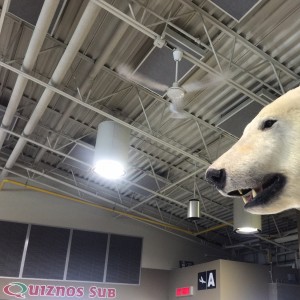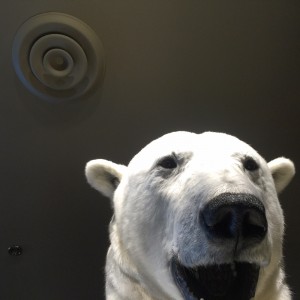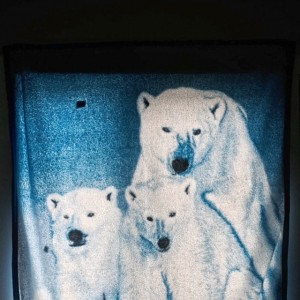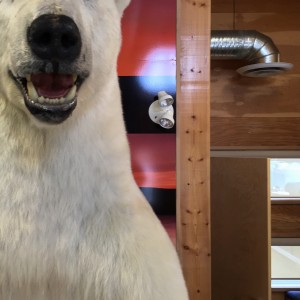Encounters with art and design by an anthropologist and curious non-expert in visual culture.
The question, ‘what is that we can do together?’ — whoever and wherever that ‘we’ may exist — is largely a question of what is in-between us; what enables us to reach toward or withdraw from each other. What is the materiality of this in-between — the composition and intensity of its durability, viscosity, visibility, and so forth? What is it that enables us to be held in place, to be witnessed, touched, avoided, scrutinized or secured? Infrastructure is about this in-between.
Infrastructure exerts a force — not simply in the materials and energies it avails, but also the way it attracts people, draws them in, coalesces and expends their capacities. Thus, the distinction between infrastructure and sociality is fluid and pragmatic rather than definitive. People work on things to work on each other, as these things work on them.
–AbdouMaliq Simone (2012)
There are many anthropologists who can lay claim to dual sensibilities in art and anthropology. I’m not one of them. Nevertheless, for the past two years I’ve been doing a visual-making experiment about arctic urban infrastructure in friction with artists Jesse C. Jackson and Tori Foster, I use ‘friction’ in Anna Tsing’s metaphorical sense, to gesture a rubbing together of two distinct modes of working, seeing and being, which produces movement and often heat. I am motivated by an interest in the methods of these two artists, and by what they might offer my own thinking, writing and representing. I was especially interested in their practices for exploring the consistent patterns and anomalous curiosities that define urban landscapes. They have worked in cosmopolitan cities, like Toronto, Los Angeles and Beijing. I asked them to join me where I’ve long worked, in a small town of 4000, just above the 60th parallel in Canada’s Northwest Territories. Hay River is a peri-urban transportation town and a key node in arctic extractive networks: it’s a staging area for moving resources, goods and labour in, out and around the region. When I conducted my first stretch of extended fieldwork in 2008, diamonds were the region’s largest export commodity.
We forged this collaboration without expectation or pretense that my art colleagues and I would adopt one another’s modalities. Ultimately, they aren’t working to take on anthropology’s concerns, and I’m not en route to becoming a media artist. At times, I sense that they are exhausted with my ‘humanistic’ impulses. I’m easily frustrated by their attention to the technological. ‘Friction’ is the correct word. Nevertheless, we are drawn into each other’s orbits, and are finding ourselves part of the swelling artistic and scholarly interest in resource extraction—its cultural geographies and the infrastructures that support it.
Last week, Rhizome published an editorial called ‘How to See Infrastructure: A Guide for Seven Billion Primates’. The piece holds that ‘Infrastructure is drastically important to our way of life, and largely kept out of sight’. Drawing on Donna Haraway’s writing, the piece moves on to suggest that what is needed are ‘situated knowledges that teach us what is underneath our society, rather than simply metering information as commodity through more optic tubes’. The piece highlights several artistic and ethnographic interventions that do the work of making certain kinds of infrastructure visible. The text presents infrastructure and invisibility as deeply interrelated. The joke, or so I am told, is that you don’t notice infrastructure until it is broken. The issue seems to be one of awareness and patterns of attention, rather than ‘visibility’ per se. I always have a thumb, but once I break it, I understand more profoundly what it does for me. That said, some people are likely deeply attuned to thumb-ness (a pianist, a rock climber). I am without those habits of attention.
Part of our experiment has left me thinking about how to attend to modes of attending, through visual practice and ethnographic writing. Sometimes, I gain ground for thinking about this in unexpected ways. Most recently, it was at the airport in Yellowknife. Jesse and I were just arriving for summer fieldwork. He took a photo of a taxidermy polar bear with the sign for the airport’s Quiznos sandwich shop in the background. The bear is mounted in the middle of the sole luggage carousel, displayed with a seal diving through a white velvet iceberg. When you arrive, you inevitably stand facing the charismatic megafauna* as you wait for your checked items.

Jesse’s photo intended to subvert the clichéd dead-on snapshot of the installation. While he was taking it, many people around us were taking the quintessential Yellowknife airport picture. Even locals snap them. They post these photos to social media to let their families know they are near home. I have several iterations in my own collection. The photo isn’t part of Jesse’s art practice. He mostly wanted to make his wife and me laugh by suggesting the bear had a taste for Quiznos. However, we began talking about the construction of the airport, the increased flight traffic in the last ten years, and the prominent-in-airports phenomenon, beaver modernism (modern construction as a platform for expressing Canadian nationalism). Trained as an architect, Jesse could contextualize the taxidermy as part of a larger project. At the same time, I was deeply engrossed by different local and global accents, by the men and women looking around for the shuttle to the diamond mine’s private hangar, by parents picking up children who have been at university for the year, by the plastic Tupperware bins stuffed with consumer goods unavailable in the more remote communities.

As we moved from around the capital city and on to the transportation town of Hay River, we came across more polar bear / infrastructure and kept a record. Polar bears are both expected and out-of-place in most parts of Denedeh. The Great Slave Lake region is Dene territory and known for excellent fishing. There are bison, caribou and moose but no polar bears. Polar bears are much further north on both sides of the Beaufort Sea. The polar bear works as an icon of arctic-ness, among other things. Our images of polar bears, artistic castaways of sorts, were beginning to help me articulate the dual, sometimes competing impulses of arctic infrastructure. There are the habits of meaning and overt expressions of the local (e.g., polar bear iconography that some people are structured to stare at while waiting in an airport or eating in a hotel) held in the same frames as everyday elements that shape how people, goods move in and out of the region in ways that seem ordinary (e.g. plastic Tupperware). My priority isn’t to ‘reveal the invisible’, but rather to attend to the pronounced and the subtle unfinished systems that enable circulation of goods, knowledge, meaning, people and power. More than just creating an account of such systems, I’m trying to understand how differently situated groups learn to attend to some elements more so than others.

This summer I am directing my reading, writing and friction-practice towards thinking about how digital and art-based methods of data collection and output assist or hinder the task of understanding the shape, experience and ways of attending to resource extraction and infrastructure. As a group we are consistently confronted with the question, ‘What is that we can do together?’ In a later post, I will say more about what it is we have done. Spoiler, it doesn’t involve polar bears.

* For more on the anthropology of charismatic megafauna see the work of Hannah Voorhees (polar bears) and that of Danielle DiNovelli-Lang (Alaskan brown bears). For a look at the seemingly less charismatic, but no less significant, species of fish in the NWT, see the work of Zoe Todd. For Alaksan slamon, see Karen Hébert’s excellent piece in American Anthropologist.
**If you haven’t yet read Lisa Stevenson’s Life Beside Itself: Imagining Care in the Canadian Arctic, run don’t walk. Thoughtful responses to it are on Somatosphere. There is an excellent curated collected of essays on Infrastructure on Cultural Anthropology.
Lindsay, thanks for this piece. The idea of friection a rubbing together of distinct modes that produces movement and often heat resonates strongly with my experience in advertising and current interest in how project teams produce innovation. In ad agency life the different ways of being in the world embodied in account executives, marketing strategists, and creatives are always rubbing up against each other in ways that can either stimulate or impede innovation.
I am almost much taken with your connection between infrastructure and the invisible. I am reminded that infrastructure tends to move historically from highly visible event, when something is constructed, to the invisibility produced by amnesia when routine use has made it part of the background.